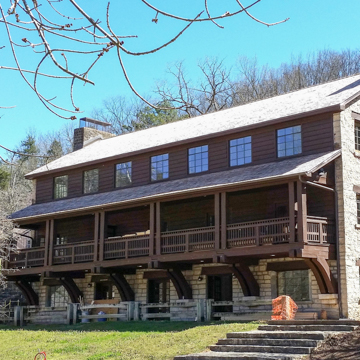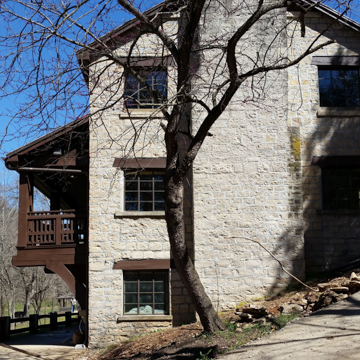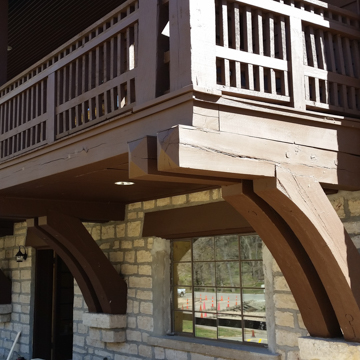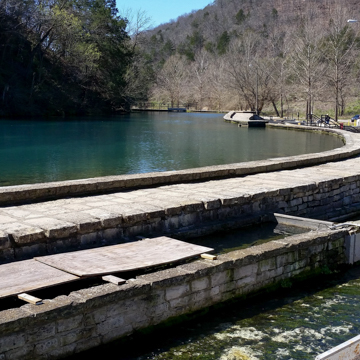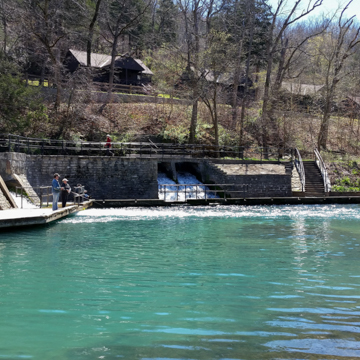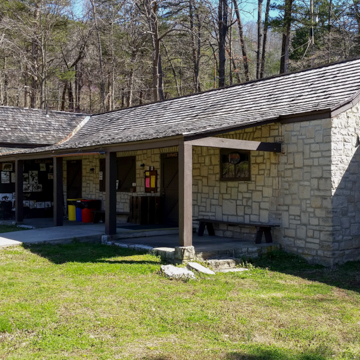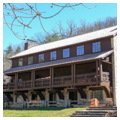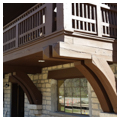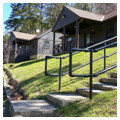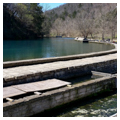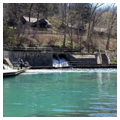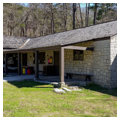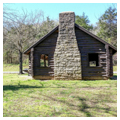In 1847, the first land surveyors labeled the rugged hills of this wilderness in the Ozarks Mountains "the steepest description of stony mountains entirely unfit for cultivation." It remains a picturesque area notable for its ruggedness, abundant wildlife, oak forests, glades, deep hollows, high knobs, and trails. The park, which was established in 1929, encompasses more than 4,000 acres, with more than 2,000 of these designated the Roaring River Hills Wild Area, where roads and mechanical equipment are prohibited, thus protecting the rugged character of landscape.
Overlooking Roaring River is the lodge built by the Civilian Conservation Corps (CCC), a three-story rectangular building of native stone and wood construction, with a pitched gable roof and chimneys at each end, and massive paired brackets that support the second story verandah. The lodge's exterior is substantially as it was when completed in 1938. A product of this important New Deal relief program for unemployed men, the building exemplifies the ideals of rustic park architecture promoted by the National Park Service and is unique among Great Depression–era structures in the Missouri park system as the only planned and purpose-built hotel. Its newer counterpart, the Emory Melton Conference Center Inn (1998, Shaughnessy Fickel Scott), nestles into the nearby hill that drops down to the river. Like the lodge, the inn blends into the landscape by virtue of its construction materials of timber and stone and its low roof line. Huge stone piers flank the inn’s entrance, which opens into a large central lounge and its fireplace. The inn accommodates conferences, meetings, and large family gatherings, whereas the lodge by the river reflects the simpler outdoor activities of its time and the slower pace of sitting on the verandah and watching the river flow by.
Other buildings and structures within the park include camping centers with accommodations for recreational vehicles and tents, cabins of various sizes, a nature center, swimming facilities, and fish-cleaning stations. Along with the lodge, from 1933 to 1939 the CCC developed cabins and other park buildings and hiking trails and improved the fish hatchery. The trout hatchery was privately built in 1910, but was sold at auction in 1928 to Thomas Sayman, who donated it to the State of Missouri. The hatchery's dam, stone pools, and buildings, which appear to be a natural part of the environment, draw their water from Roaring River, averaging 20.4 million gallons per day.
In 1936 the Cassville Ranger Station on MO 248 east of Cassville near Mineral Springs Road was built by the Shell Knob Camp of the CCC. This complex of several frame and limestone buildings includes the Ranger's office, a one-and-a-half-story frame and limestone building; the Ranger's dwelling, a Craftsman-influenced house, with a garage; a warehouse; and an oil house. The exterior stonework of all five is the most unifying characteristic of the "district," as it is known, and a model of cooperation between the USDA Forest Service, the CCC, and the Mark Twain National Forest Service's emphasis on rustic architectural designs.














